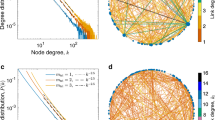Abstract
Simplicial complexes provide a useful framework of higher-order networks that model co-occurrences and interactions among more than two elements, and are also equipped with a mathematical foundation in algebraic topology. In this paper, we investigate the temporal growth processes of simplicial complexes derived from human activities and communication on social media from a perspective of burst vertices. First, we empirically show that most of new simplices contain burst vertices, while for each new simplex containing a burst vertex, its vertices other than the corresponding burst vertex do not necessarily co-occur with the burst vertex itself within the not so distant past. We thus examine the problem of finding which burst vertex is contained in a new simplex from the occurrence history of burst vertices. In particular, we focus on analyzing the influence of the occurrence events of burst vertices in terms of time-decays. To this end, we propose a probabilistic model incorporating a log-normal-like time-decay factor and give its learning method. Using real social media datasets, we demonstrate the significance of the proposed model in terms of prediction performance, and uncover the time-decay effects of burst vertices in the occurrence of new simplices by applying the proposed model.
Access this chapter
Tax calculation will be finalised at checkout
Purchases are for personal use only
Similar content being viewed by others
Notes
- 1.
In our experiments, we set \(\Delta t_1\) to one week (seven days) and \(\Delta t_2\) to \(2 \Delta t_1\).
- 2.
In our experiments, we set \(\Delta t_0\) to four weeks (28 days).
- 3.
- 4.
First, we removed general-purpose ingredients for Japanese food such as soy sauce, salt, sugar, water, edible oil, and so on. Furthermore, we extracted the ingredients appearing in five or more recipes.
- 5.
- 6.
References
Barabási, A.L.: The origin of bursts and heavy tails in human dynamics. Nature 435, 207–211 (2005)
Barabási, A.L., Albert, R.: Emergence of scaling in random networks. Science 286, 509–512 (1999)
Benson, A.R., Abebe, R., Schaub, M.T., Jadbabaie, A., Kleinberg, J.: Simplicial closure and higher-order link prediction. Proc. Natl. Acad. Sci. U.S.A. 115(48), E11221–E11230 (2019)
Cencetti, G., Battiston, F., Lepri, B., Karsai, M.: Temporal properties of higher-order interactions in social networks. Sci. Rep. 11(7028), 1–7028 (2021)
Courtney, O., Bianconi, G.: Generalized network structures: the configuration model and the canonical ensemble of simplicial complexes. Phys. Rev. E 93, 062311:1–062311:14 (2016)
De, A., Valera, I., Ganguly, N., Bhattacharya, S., Gomez-Rodriguez, M.: Learning and forecasting opinion dynamics in social networks. In: Proceedings of NIPS 2016, pp. 397–405 (2016)
Estrada, E., Ross, G.J.: Centralities in simplicial complexes. applications to protein interaction networks. J. Theoret. Biol. 438, 46–60 (2018)
Farajtabar, M., Du, N., Gomez-Rodriguez, M., Valera, I., Zha, H., Song, L.: Shaping social activity by incentivizing users. In: Proceedings of NIPS 2014, pp. 2474–2482 (2014)
Iacopini, I., Petri, G., Barrat, A., Latora, V.: Simplicial models of social contagion. Nat. Commun. 9, 2485:1–1399:9 (2019)
Karsai, M., Kaski, K., Barabási, A.L., Kertész, J.: Universal features of correlated bursty behaviour. Sci. Rep. 2, 397:1–397:7 (2012)
Kleinberg, J.: Bursty and hierarchical structure in streams. Data Min. Knowl. Disc. 7, 373–397 (2003)
Lü, L., Zhou, T.: Link prediction in complex networks: a survey. Phys. A 390(6), 1150–1170 (2011)
Petri, G., et al.: Homological scaffolds of brain functional networks. J. Royal Soc. Interface 11, 20140873:1–20140873:10 (2014)
Preti, G., Moralest, G.D.F., Bonchi, F.: Strud: Truss decomposition of simplicial ccomplexes. In: Proceedings of WWW 2021, pp. 3408–3418 (2021)
Shen, H., Wang, D., Song, C., Barabási, A.L.: Modeling and predicting popularity dynamics via reinforced poisson processes. In: Proceedings of AAAI 2014, pp. 291–297 (2014)
Swan, R., Allan, J.: Automatic generation of overview timelines. In: Proceedings of SIGIR 2000, pp. 49–56 (2000)
Wang, D., Song, C., Barabási, A.L.: Quantifying long-term scientific impact. Science 342(6154), 127–132 (2013)
Yang, D., Zhang, D., Qu, B.: Participatory cultural mapping based on collective behavior in location based social networks. ACM Trans. Intell. Syst. Technol. 7, 30:1–30:23 (2016)
Zhang, M., Cui, Z., Jiang, S., Chen, Y.: Beyond link prediction: predicting hyperlinks in adjacency space. In: Proceedings of AAAI 2018. pp. 4430–4437 (2018)
Zhao, Q., Erdogdu, M., He, H., Rajaraman, A., Leskovec, J.: Seismic: a self-exciting point process model for predicting tweet popularity. In: Proceedings of KDD 2015, pp. 1513–1522 (2015)
Zhou, K., Zha, H., Song, L.: Learning social infectivity in sparse low-rank networks using multi-dimensional hawkes processes. In: Proceedings of AISTATS 2013, pp. 641–649 (2013)
Acknowledgements
This work was supported in part by JSPS KAKENHI Grant Number JP21K12152. The Cookpad dataset we used in this paper was provided by Cookpad Inc. and National Institute of Informatics.
Author information
Authors and Affiliations
Corresponding author
Editor information
Editors and Affiliations
Rights and permissions
Copyright information
© 2024 The Author(s), under exclusive license to Springer Nature Switzerland AG
About this paper
Cite this paper
Takai, C., Kumano, M., Kimura, M. (2024). Analyzing Temporal Influence of Burst Vertices in Growing Social Simplicial Complexes. In: Cherifi, H., Rocha, L.M., Cherifi, C., Donduran, M. (eds) Complex Networks & Their Applications XII. COMPLEX NETWORKS 2023. Studies in Computational Intelligence, vol 1144. Springer, Cham. https://doi.org/10.1007/978-3-031-53503-1_1
Download citation
DOI: https://doi.org/10.1007/978-3-031-53503-1_1
Published:
Publisher Name: Springer, Cham
Print ISBN: 978-3-031-53502-4
Online ISBN: 978-3-031-53503-1
eBook Packages: EngineeringEngineering (R0)




